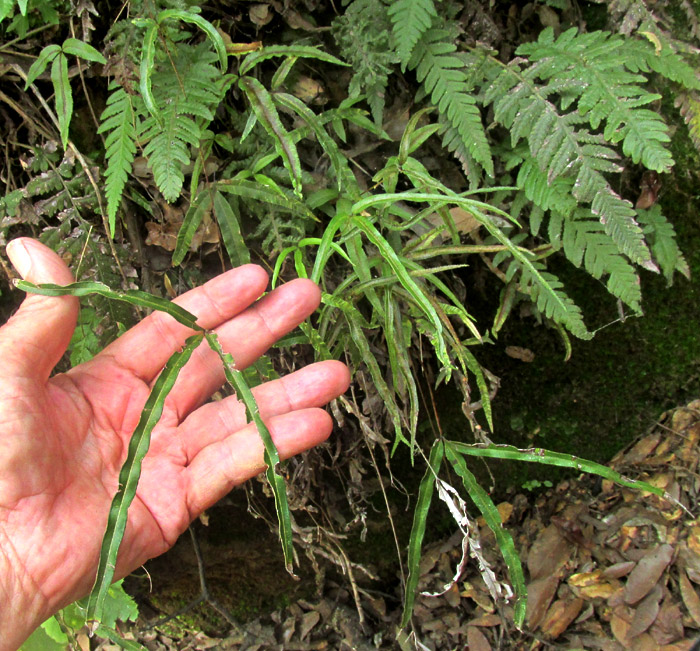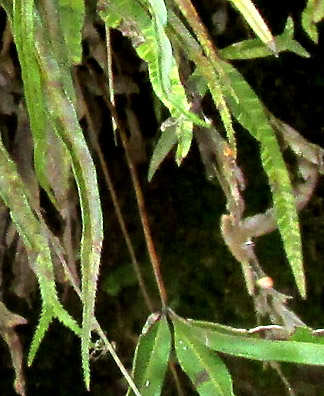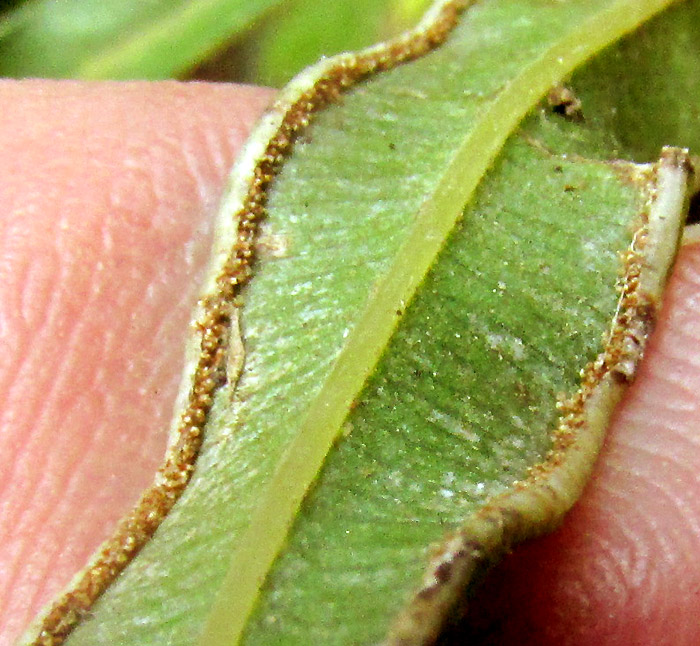Excerpts from Jim Conrad's
Naturalist Newsletter
Entry dated November 9, 2023, from notes taken near Cascadas de La Piedad waterfall 3kms NW of the community of San Pablo, municipality of Almeaco de Bonfil; in canyon of La Piedad below the falls; N20.1017°, W100.0041°, elevation 2360 meters (7750ft); extreme southern Querétaro state, MÉXICO
CRETAN BRAKE

In the bottom of La Piedad canyon, on a mossy, volcanic, balsatic boulder, the above fern with its three slender, brittle pinnae forming crowfoot-shaped fronds atop long, stiff stems, or stipes, grew in a population of several fern species. Note at the picture's top, left corner a smaller frond with shorter but wider pinnae.
I couldn't recall a fern with such curious fronds, and looked amid the tangle for fronds with more or fewer divisions, but there were none. A previous season's dead, dried-out and crumbling fronds formed a shag below the green ones, and one of them might once have born five pinnately arranged pinnae, but I couldn't be sure. Still, I wondered whether during a rainier year the fern might have produced more pinnae. Currently this area is experiencing a continuing two-year period classified by the North American Drought Monitor as a D3 Extreme Drought.

While searching for fronds of a different shape I did, however, find what's seen at the right. At the image's top, right corner, and the lower left one, note the slender pinna tips which are forked. Forked pinna tips often occur in aberrant horticultural forms, such as the Fishtail Swordfern, and Pigmy Swordfern. Such ferns normally turn up in pots or gardens, not natural settings, though sometimes they escape into the wild. I began suspecting that such was the case here: We must have a weed fern.

As seen above, the main clue to the fern's identity was visible on a pinna's underside. There, brown, grainy, spore-producing sporangia peeped from inside the pinna's underturned margins, the false indusia. Such false indusia point to the Maidenhair Fern Family, the Pteridaceae. Later I'd learn that another feature visible in the above photo is that the pinna's veins remain separated after branching from midrib; they don't curve and meet, forming a reticulating network.
The Pteridaceae is a tricky family. Experts don't agree on how to define it, or even what its name should be. As the online Flora of North America says of the family's species adapted for deserty, or xeric, conditions, they "... have undergone extensive parallel and convergent evolution, and they have frustrated attempts to produce a natural generic classification based on macromorphologic characteristics alone." In other words, identifying species even to genus level without microscopic help can be hard.
Still, because of the shapes and disposition of pinnae, I had a hunch that this was a member of the genus Pteris, one of the brake ferns -- different from the cliffbrakes -- such as the Chinese Brake, a common weed-fern in the Yucatan. For our Bajío region of upland central Mexico, the Flora del Bajío reports seven documented Pteris species. Of those seven, if the fronds are only once-divided, pinna veins don't connect with one another, and the pinnae are arranged in less than five pairs along the midrib, you have PTERIS CRETICA, which in our area is described as inhabiting humid, shady highland places.
Pteris cretica, often known as the Cretan Brake, is native to much of the warm parts of the Old World, and is invasive from the US's southern states south to northwestern South America. In its native lands, where it was adapted for humid, warm climates, now it is rare and reduced to relict populations. In its fragmented condition, the species has undergone polyploidy (acquiring more than the normal two complete sets of chromosomes), hybridization and apomixis (non-sexual reproduction), resulting in certain appearances appreciated by gardeners. Planted individuals escape into the wild and genes mix even more.
Confirming our fern as a Cretan Brake was tricky, because the vast majority of Internet images of the species are of plants growing in pots and gardens. Nearly all such plants produce more than three pinnae, and the pinnae are wider. Certain ornamental forms display a white stripe running down each pinna's center. A few plants photographed in the wild look more or less like ours, but even they nearly always bear more than three pinnae. My impression is that our Pteris cretica has been severely stunted by the drought, and its occasionally forking pinna tips suggest that its genes have been jumbled more than usual.
In fact, the Cretan Brake is famous among geneticists because the first observation of apogamy taking place was observed by William Farlow at Harvard, in 1874, studying Cretan Brakes. Apogamy in ferns involves the asexual development of the spore-producing fern body, the sporophyte, from the gametophyte, which is the tiny, heart-shaped stage of the fern life cycle, the prothallus. On our Fern Prothalli page, I explained how prothalli fit into the fern's life cycle like this: "It's almost like a dog and a snail alternating with one another in one life, with snails (like prothalli) having sex to produce dogs, but the dogs (like spore-producing fronds) walking around occasionally budding off spores, from which snails emerge."
In the 2013 study by Tassanai Jaruwattanaphan and others entitled "Reconstructing Hybrid Speciation Events in the Pteris cretica Group (Pteridaceae) in Japan and Adjacent Regions," it's said that the single species "Pteris cretica has been reported to contain four cyto-reproductive types: diploid, triploid, and tetraploid agamosporous, and diploid sexual types," in which even further variation was found within both the diploid and triploid ploidy level." Apparently, our particular fern's genes are given to occasionally producing forked pinna tips.
Traditional medicinal uses of Cretan Brake in Mexico aren't found, but SD Rout and others in a 2009 study entitled "Ethnomedicinal studies on some pteridophytes of Similipal Biosphere Reserve, Orissa, India," documented local people using Cretan Brake to treat warts, wounds and inflammations.